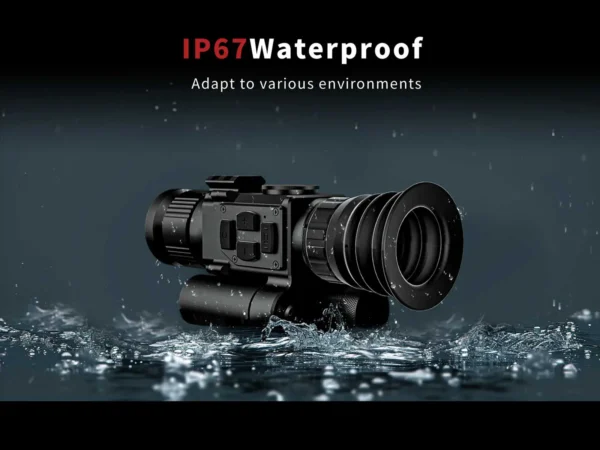Infrared Thermal Night Vision Telescope | 1100m Detection Range in Total Darkness
发布时间:สิงหาคม 6, 2025 分类:Blog 浏览量:939
Night vision technology has come a long way. Modern infrared thermal night vision telescopes offer unmatched capabilities, even in total darkness. Whether for hunting, surveillance, or security, these devices provide a detection range of up to 1100 meters, making them essential tools for nighttime operations. But with so many options available, why should you choose infrared over traditional night vision systems?
Common Problems with Traditional Night Vision
- Limited Range: Traditional night vision systems often fall short in extreme low-light conditions. They can only detect objects in close proximity, reducing their effectiveness in dark environments.
- Dependence on Ambient Light: Standard night vision devices require some ambient light to function, making them unreliable during cloudy nights or in absolute darkness.
- Clarity Issues: The image quality in traditional systems can degrade rapidly with distance, making it difficult to identify targets with precision.
How Infrared Thermal Night Vision Solves These Problems
Infrared thermal technology uses heat signatures to detect objects, not light. This gives users the ability to see through total darkness, fog, smoke, and even light vegetation. Infrared thermal night vision telescopes, like those with a 1100-meter detection range, can provide clear images in all conditions. Unlike traditional systems, infrared technology doesn’t depend on external light, making it ideal for true low-light and no-light environments.

Real-World Application of Infrared Thermal Night Vision
- Hunting: Infrared thermal night vision allows hunters to detect animals by their body heat, even in pitch darkness. The 1100m range ensures they can spot prey at a distance, improving both safety and accuracy.
- Surveillance: For security teams, being able to monitor an area during the night without additional lighting is crucial. Thermal imaging helps detect intruders without giving away your position.
- Search and Rescue: In search-and-rescue operations, infrared thermal devices can identify heat sources, helping teams locate missing persons or survivors in harsh environments, even in zero visibility.
What Makes Infrared Thermal Night Vision So Effective?
- Detection in Total Darkness: Unlike traditional systems that require some ambient light, thermal imaging detects heat, allowing you to see objects even in total darkness.
- All-Weather Use: Infrared systems perform well in all weather conditions, including fog, rain, and smoke, making them perfect for both military and civilian applications.
- Long Detection Range: The 1100-meter range ensures objects are detected from a distance, offering superior capability over traditional night vision.
Key Features of the Infrared Thermal Night Vision Telescope
| Feature | Infrared Thermal Night Vision Telescope | Traditional Night Vision |
|---|---|---|
| Detection Range | 1100 meters | 100-300 meters |
| Technology | Thermal Imaging (Heat Detection) | Image Enhancement (Light) |
| Weather Resistance | High Resistance to Rain, Snow, Fog | Limited in Low Light & Weather Conditions |
| Clarity | High Clarity in Complete Darkness | Degrades with Distance |
| Power Efficiency | Low Power Consumption | Higher Power Usage |
How the 1100m Detection Range Enhances Performance
The ability to detect objects at up to 1100 meters is a game-changer. It allows operators to monitor vast areas without getting too close to their targets. Whether it's for security, wildlife observation, or tactical operations, this extended range significantly improves operational effectiveness.
The Impact of Infrared Thermal Night Vision on Various Industries
- Military and Defense: The ability to detect heat signatures, whether from vehicles, personnel, or equipment, provides a clear strategic advantage. Thermal vision helps in planning tactical movements during nighttime operations.
- Law Enforcement: Law enforcement agencies use infrared thermal devices for surveillance and search operations, particularly in urban environments where visibility can be obstructed by buildings and vegetation.
- Wildlife Observation: In wildlife research, infrared technology helps monitor animals without disturbing their natural habitat, making it an invaluable tool for researchers.
Why Choose an Infrared Thermal Night Vision Telescope?
If you're looking for the best night vision technology available, infrared thermal night vision is the clear choice. With its 1100-meter detection range, superior image clarity, and unmatched performance in low-light conditions, it outperforms traditional systems in every way.
Where to Buy the Best Infrared Thermal Night Vision Telescopes?
For high-quality infrared thermal night vision telescopes, look for certified suppliers who offer reliable products tested for accuracy and durability. Our models come with precise specifications and advanced technology, ensuring you get the best performance possible.Please visit our product page for more details!

